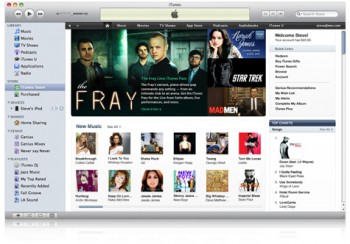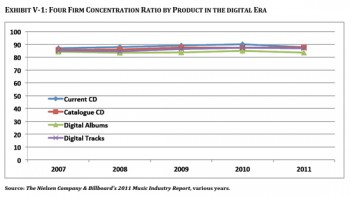U.S. Music Market To Grow 5.5% By 2016, Digital to Overtake Physical Sales
Via Billboard:
This year will mark the first time digital distribution revenue will overtake physical distribution in U.S. music sales, according to Pricewaterhouse Coopers’ Entertainment & Media Outlook 2012-2016, issued Tuesday. The continued rise of subscription-based streaming music services and digital downloads are projected to help the U.S. music market rise to $19.8 billion by 2016, a 5.5% increase from the $15.2 billion in 2011. Additionally, radio is projected to total $22.5 billion in 2016, a 4.1% increase from 2011, on the strength of increased spending on broadcast, satellite and online radio advertising.
“If you go back to 2007, 2008 and 2009, we’re at the end of a cycle where tremendous recorded music sales really drove the industry,” says Greg Boyer, PwC’s managing director of entertainment, media and communications. “After the 38 to 40% downturn over that rough period, the innovation, access and ability of subscription services is fueling the ability to at the very least get back to very healthy revenue numbers. It’s also providing unique opportunities for artists, for the labels, and unique opportunities for other companies that are growing up in that new environment.”
Declines in physical distribution will continue over the next five years, albeit at single-digit percentage rates, dropping from $3.4 billion in 2011 to $2.2 billion at an 8.0% compound annual decrease. Digital distribution, buoyed by a boost from streaming services, will rise at an 11.7% compound annual rate to $5.5 billion in 2016 from $3.1 billion in 2011. Total spending on recorded music will rise at a 3.4% compound annual rate to $7.7 billion in 2016, from $6.5 billion in 2011.
Live music will also see growth during the time period, with spending on concerts and music festival expected to expand at a 7% compound annual from from $8.7 billion in 2011 to $12.2 billion in 2016. Live music is also attributed as the leading factor for the U.S. music market’s 3.4% growth in 2011, with a return in concert ticket revenues making up for the declines in recorded music sales.
One revenue source not included in PwC’s report is commercial synch revenue, which IFPI included for the first time in its global “Recording Industry In Numbers” report this March. “It’s not included in our base projections, but it’s certainly a growing aspect of the business,” says Boyer. “More importantly, it’s one of the more stable parts of the business you can really depend on. With the recent M&A activity in music and how some of that has been priced into the market, specifically on the publishing and licensing side, you’re seeing very significant valuations related to the recorded music companies because of the stability of those revenues. I think you’ll see that continue as a core part of the next evolution of how the value of the labels and and the record companies is determined.”
On the radio front, 2012 will see a return of ad revenue after terrestrial ads declined 0.1% in 2011. Automotive and political spending will drive much of the growth this year, which will eventually slow down to a 3.0% compound annual increase to $18.2 billion by 2016, compared to $15.7 billion in 2011. Broadcast advertising will increase at a 2.7% compound rate through 2016, while online will grow by 11.5% during the same time period from $465 million in 2011 to $802 million in 2016. Satellite radio advertising will also rise from $74 million in 2011 to $116 million, at a 9.4% compound annual increase, with satellite-radio subscription spending expanding from $2.6 billion in 2011 to $4.1 billion in 2016. –Allindstrom
Indie Labels Are Now Heavily Dependent on Major Label Distribution
You don’t need a fancy report to tell you this. Just look at what’s happened to the so-called ‘indie digital distribution’ space for ample evidence of major label domination. The Orchard now features a massive ownership share by Sony Music, INgrooves Fontana is substantially owned by Universal Music Group, and once-indies like IODA and Iris Distribution have been swallowed alive by the machine.
Indie groups like A2IM will scream that they’re still in control, they’ll blast Soundscan and the majors for shady marketshare counting. But according to a report just issued by the Consumer Federation of America and Public Knowledge, the fact that majors can get away with this creative counting proves they’re in a position of power. ”We interpret the recent brouhaha over the calculation of market shares as a demonstration that the independent labels have failed to diminish the market power of the dominant firms,” the report grates. ”We believe this dispute proves the continued importance of the majors, not their imminent demise. While independent labels have grown, they have been unable to escape from the domination of the major labels.”
But just how dominant are the majors in this picture?
“The independent labels are dependent on the majors for distribution of over 60 percent of their content, hardly a demonstration of their ability to challenge the majors with regard to fostering new distribution.”
Methodology please? The groups calculated that indie marketshare is roughly 30 percent regardless of the ultimate distributor. But when indie-only distribution channels are isolated, that marketshare shrivels to just 12 percent.
But who really cares about that? Universal Music Group, that’s who, especially as it tries to convince lawmakers to approve its pending acquisition of EMI. Which would explain why the label is suddenly trying to undo its marketshare-grabbing calculations with an “eleventh hour flip-flop,” according to the report. Because smaller marketshare means a smaller anti-competitive threat, which means the game suddenly changes. And both Consumer Federation and Public Knowledge, both ardent opponents of this merger, are more than happy to expose that game.
But wait: majors still control a massive amount of music the mainstream wants – across physical and digital. Which means the broader picture looks like this:
Perhaps this is just a prelude to the real problem. After all, massively-funded companies like Spotify aren’t paying royalty ransoms and doling out ownership stakes because it’s fun. ”Alternative distribution models must gain access to the content of the majors to succeed because, as we have already seen, the majors control such a large share of the music that sells across all media and genres.”
And more importantly, they can crush the small-but-growing level of independent marketshare by using these tactics. ”Major labels can stifle this competition by limiting the number of successful digital distribution platforms, which are the very places where independent labels’ offerings can compete with those of the major labels on a level playing field. The major record labels may accomplish this by withholding licenses entirely or by demanding high advances, royalties disproportionate to their market share, or an equity stake in the digital service as a condition of a license.
“Any of these tactics threaten the long‐ term sustainability of independent labels.”
The Indie Artist Launch Plan
Indie Artist/Band Career Got your atte
ntion? Good. Now obviously there is no ONE path to launching a career as a musical artist, whether you are going the Indie Route or aim to get picked up by a Major Label…
But I fear that the overwhelming DIY concepts saturating the already overloaded artist/musician is causing analysis paralysis and/or an unneeded amount of complication surrounding what one really needs to do to build your foundation as an Independent Artist or Band.
Throughout this two part article series I am going to do my best to break the component parts down to understandable and slightly over-simplified concepts to leave you with what I believe you’ll find very valuable insight and a message that you can apply to your life/career in some helpful way.
Or, screw it… If you read this article, 4 million dollars will fall out of the sky and land on your doorstep, and the girl/guy of your dreams will instantly show up in your life… Ok. NOW you’ll read!
But today, in retrospect of what I know now, and from working with artists and bands to progress and develop their career, launch albums, and get more clear on what they need to do and as a DIY Indie Artist, there are a few things I would do differently to build the foundation of my musical career…
This is what I would like to share, and exactly what I would have liked to have had someone tell me eight years ago, so hopefully you will be able to benefit from this.
What’s the Problem?
Read the rest after the jump! –Music Think Tank
There seems to be two root problems with growing an Indie Artist Music career amidst the DIY revolution:
1. Artist Career/Development – Developing your talent, the knowledge, skill-sets, and experience, to create the foundation for a long-term, sustainable career doing what you love
and
2. Clear Focus – Singularly focused-passionate and committed effort, with clear strategy and confident execution, done consistently, until goals and/milestones are achieved
Although, grossly oversimplified, the practical solution is-then, KNOWING, confidently, what few key things you should be doing, and then consistently doing them.
At the end of the day, that is all we can do. That is all anyone can do. We musicians are generally NOT great multi-taskers, and that is actually a good thing. If we nail our focus on the right things, for long enough, consistently enough, anything is possible.
Everything really boils down to that, right?
Because the “Tribe Building,” D2Fan model is undoubtably real, isn’t it?
It’s been proven, time and time again. It is the future for both independent artists and signed acts.
Plus the flexibility and room for creativity for those who truly believe, and are ready, is enormously wide open for you to fill in with your imagination and work ethic.
Undeniably… Anyone with certain – learn-able attributes and well developed talents with music that people enjoy listening to can generally build a fan-base as big and as creatively as one can imagine.
With that fan-base, you can seek funding, produce records, sell music, sell merch, make connections, and make money. It’s been done. There is no mystery about this possibility.
“…But Jamie,
it’s so easy to say these things, it’s not all that simple.” You are absolutely right. I do not disagree with that at all. It’s VERY tough. It’s just like ANY business or business venture because there is a ton of risk and a ton of things that have to go right, and NOT go wrong. You have to stay consistent, and work EVEN when you don’t FEEL like it.
You have moving pieces and people get on each others’ nerves… Unnecessary amounts of energy get spent on the wrong things.. People start to doubt themselves, misinterpret the “Signs” the “Universal Wizards” are sending out, and they give up, or slowly fizzle out, etc.
Look, for the most part, we all get that you have to do several things really well. You have to make great music. You have to market yourself and your music just as well, you have to manage your business, bla bla bla… These are all theoretically AND very practically, the truth. And you may understand that…
But if you don’t have a structure in place, one that is built on a solid strategy, and of which you enjoy doing almost all of the things, you are going to have a hard time staying consistent to the level that is required to make massive amounts of momentum, which is required to grow into a professional.
By that, I mean either make enough waves to get enough attention to get signed, or create a unique DIY career with your music or Band, or really anything else you can dream up for yourself.
Bottom Line…
Right Knowledge, Right Strategy, + Consistency = Get to Your Next Level.
Whatever that may be.
I think the reason that most bands/acts/artists/musicians who sort of flounder and make slow progress, who want to build a career today, don’t have the knowledge and the strategy when it comes to the business and marketing end of things…
This creates a blindness, and that lack of clarity = confusion, luck, chance type thinking, and this keeps people from growing their careers. In other words, they aren’t doing all of the things they know they can, and aren’t active in creating and shaping their career..
-Turning each show into an EVENT and capitalizing on the opportunities that present themselves
-Creatively hounding the local media folk to get some attention that you could build on
-Building and keeping in touch with your email list, and treating that as your biggest asset
Here’s how I know this is true… BECAUSE ARTISTS/MUSICIANS are the SMARTEST and MOST CREATIVE people I have ever me
t. Period. End of story, and I have been around just about every type of person.
This is different than a lot of other industries because unlike the get rich quick “opportunity seekers,” our industry has its heart in the right place. Maybe one of the only things we got right, but it counts for a lot!
The other VERY REAL challenge that we all face is… FOCUS. Website, SEO, Social Media, Booking, Marketing, Performing, Production, Picking kids up from daycare, dealing with family problems, staying healthy, IT IS INFINITE. There is too much information. You know this, you have heard this… But what do you do to overcome it? Do you focus and prioritize?
In other words, there is just too much information and ideas and things to try to manage that the basics sort of get lost, and some very basic things like creating a strategy for what you are going to do becomes ANTI-Music, or just “not rock and roll man…” Sure. It may not be the way Hendrix did it, but those days are long gone man.
Although, it’s no longer really part of the built in model by labels, let’s not forget that artist development is real.
I think for anyone just starting out in their career, the main thing to remember is that there is an INCUBATION period. Just as with anything. In any job, or any career, you put in the consistent work and you do certain things in a certain way for a couple of years… Then there is almost NO way, UNLESS you for some reason STOP, that you won’t conclude with one of two findings…
- This IS the foundation for the rest of my life, this is the right path, I have found my area, my audience, honed my chops, and know that I can grow a solid career doing this…
- OR, this is NOT the path for me. Maybe I don’t really want to do THIS, and by now you understand that. But you should know that fairly early, and you don’t need to spend two years performing in front of people if you hate doing it and do not love it.
Read the Feedback and Adjust
Be cognizant of the feedback you are getting… Of course, don’t just go and keep playing the same music at the same places if everyone keeps booing you off stage. Adjust, try new things.
This is not hard for artists and musicians, as most of us are intuitive, and can quickly tell whether something works, or something doesn’t. We just have to go out and try it.
So What Are Those Key Things I Started To Mention Earlier?
Since Artist Development is OUR job, what ARE the things – that if you did and were consistent in doing would set you up for the best chance for success over a period of say two years time?
I had to break this article into a two part series because it got too long. So STAY TUNED for Part Two.




